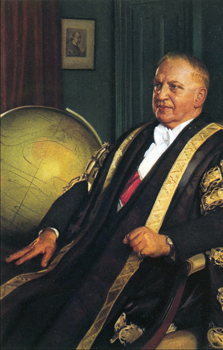Sir Edward Appleton
Nobel Prize winner and pioneer in radio physics, Sir Edward Appleton, studied and was also employed as a Lab Technician at Bradford Technical College from 1909 to 1911.
 Edward Victor Appleton was born in Bradford on 6
September, 1892, to Peter Appleton and his wife Mary
Wilcock.
Educated at Hanson Grammar School, where he excelled
in Mathematics, Science, Language and Literature Studies,
Edward attended Bradford Technical College from 1909 to
1911, where he was also employed as Lab Technician. In
1911, aged 18, he was awarded a scholarship to attend St
John’s College, Cambridge University where he graduated
with First Class Honours in Natural Science with Physics in
1913.
Edward Victor Appleton was born in Bradford on 6
September, 1892, to Peter Appleton and his wife Mary
Wilcock.
Educated at Hanson Grammar School, where he excelled
in Mathematics, Science, Language and Literature Studies,
Edward attended Bradford Technical College from 1909 to
1911, where he was also employed as Lab Technician. In
1911, aged 18, he was awarded a scholarship to attend St
John’s College, Cambridge University where he graduated
with First Class Honours in Natural Science with Physics in
1913.
In 1913, Edward won the Wiltshire Prize and in 1914, the Hutchinson Research Studentship, studying under the tutorship of Sir JJ Thomson and Lord Rutherford. He began postgraduate work in Crystallography with Physicist Sir Lawrence Bragg, but his research studies were interrupted by World War I. Edward enlisted in the West Riding Regiment, later transferring to the Royal Engineers.
He was assigned to signal duty as a Commissioned Officer where he was first introduced to radio, then in its infancy in the military. This instigated a life-long interest in the subject and brought Appleton acclaim as a scientist. In 1920 he was appointed Assistant Demonstrator in Experimental Physics at the Cavendish Laboratory, Cambridge, where he began research the operation of radio vacuum tubes. He was later appointed Wheatstone Professor of Physics at King’s College, University of London in 1924 where he studied radio transmission and the upper atmosphere. He conducted a number of experiments and proved the existence of the ‘Kennelly Heaviside Layer’ in the upper atmosphere now called the ionosphere, the first object ever detected by radiolocation. Further experiments followed and in 1926 he discovered a higher, electrically stronger atmospheric layer, 150 miles above ground.
Named the ‘Appleton Layer’ after him, he found it reflected short waves round the earth, unaffected by atmospheric conditions, leading to the possibility of round-the-world broadcasting. In 1932 he was elected Vice-President of the American Institute of Radio Engineers. When WWII broke out in 1939, Edward was appointed Secretary of the Department of Scientific and Industrial Research. Sir Robert Watson-Watt, working on Edward’s findings on the atmospheric layers and cathode ray oscillography, developed aircraft detection radar. Edward’s research continued and he discovered that sunspots are powerful emitters of short radio waves.
Edward’s achievements were recognized by a number of honours. In 1927 he was voted a Fellow of the Royal Society of London and in 1941 received a knighthood. During 1947 he was awarded the Nobel Prize in Physics, the Medal of Merit, the highest civilian decoration of the United States at the time, and was made an Officer of the French Legion of Honour. He was also awarded the Norwegian Cross of Freedom for his war work. In 1948 the Pope appointed him to the Pontificial Academy of Science, and in 1950 he received the Royal Society of Arts’ Albert Medal for outstanding services to science and industrial research.
The Royal Society, Edinburgh awarded him the Gunning
Victoria Jubilee Prize in 1960, and in 1962, he was awarded
the Medal of Honour of the Institute of Radio Engineers of
America.
In 1949 Edward was appointed Principal and Vice Chancellor of the University of Edinburgh, a position he held
for the rest of his life.
He died on 21 April 1965.
Photograph courtesy of the University of Edinburgh